2012 | Buch
Advances in Information and Computer Security
7th International Workshop on Security, IWSEC 2012, Fukuoka, Japan, November 7-9, 2012. Proceedings
herausgegeben von: Goichiro Hanaoka, Toshihiro Yamauchi
Verlag: Springer Berlin Heidelberg
Buchreihe : Lecture Notes in Computer Science
